LED lights have revolutionized the way we light up our homes, combining energy efficiency with longevity. But like all technology, they can sometimes leave you in the dark when they fail to flicker on. Whether it’s a sudden issue or a creeping problem, understanding how to troubleshoot your LED lights is essential. It saves you time, money, and the inconvenience of unnecessary replacements. This guide will show you common snags and simple fixes to bring the light back into your rooms and ensure your LED fixtures continue to shine bright.

Common Causes of LED Light Failures
When your LED lights don’t turn on, it’s easy to assume they’ve simply burned out. However, several factors could be at play, and understanding these can help pinpoint the issue quickly.
Power Supply Interruptions
A disruption in your home’s power supply could be the culprit. It might be as simple as a tripped circuit breaker or a blown fuse. Additionally, power surges can sometimes damage LEDs. Check if other appliances are working to rule out a larger electrical issue, and ensure your LED lights are receiving the correct voltage, as too much or too little can affect their performance.
LED Bulb and Fixture Complications
LED bulbs boast an impressive lifespan, but they’re not immune to defects or wear and tear. A faulty bulb or one that’s reached the end of its life won’t turn on. Similarly, the fixture itself could be damaged or incompatible with the bulb you’re using. Double-check that your bulbs match the fixtures, and always opt for quality products that promise compatibility and durability.
Control System Glitches
For those with smart lighting systems, glitches within the control system, such as a miscommunication between your light and the app, can prevent operation. Dimmer switches not designed for LED technology can also lead to issues. Ensure all components are updated and properly connected, and use dimmers specifically meant for LED use to avoid this hiccup.
By considering these common issues, you can start to troubleshoot effectively. In most cases, the solution is simpler than expected, and knowing where to look first saves valuable time.

Step-by-Step Troubleshooting Process
Step1: Assessing Power Sources and Connections
First things first, ensure your power source is active. It sounds obvious, but it’s common to overlook the basics in our haste to find a more complex problem. Check if the outlet is working by plugging in another device. If there’s a switch controlling the power outlet, make sure it’s turned on. Inspect any power strips or extension cords for signs of damage or overload as well.
Step2: Bulb Examination Techniques
Next, look at the bulb itself. Carefully remove it from the socket and examine it for any visible damage, discoloration, or signs that it has burned out. If you have a compatible bulb that you know works, try swapping it in. This will quickly tell you whether the bulb is the issue or if you need to dig deeper.
Step3: Fixture Inspection Points
If the bulb seems fine, your attention should shift to the fixture. Look for any loose wires, signs of wear, or damage. For ceiling fixtures, make sure the power is off and carefully check the wiring within the housing. Sometimes, connections can come loose, especially if the fixture has been moved or bumped.
Step4: Evaluating Control Systems
Finally, if your setup involves a smart lighting system or dimmers, it’s time to scrutinize these elements. Check all settings in your control system; sometimes, they might be set to off or dimmed without your knowledge. Additionally, try resetting your smart lighting app or hub to clear any temporary glitches.
By following this structured approach, you’re likely to isolate the root cause of why your LED lights won’t turn on. However, if these steps haven’t shed any light on the issue, stay tuned for some advanced troubleshooting tips that might brighten things up.
Advanced Troubleshooting Techniques
Utilizing Multimeters for Continuity Checks
A multimeter is a handy tool that measures electrical properties like voltage, current, and resistance. Use it to check for continuity, which confirms that electricity can flow through the circuit uninterrupted. Here’s how to do it safely:
- Turn Off Power: Before using a multimeter on your fixture, ensure all power is switched off to avoid electric shocks.
- Set to Continuity Mode: Turn the multimeter dial to the continuity setting, often represented by a sound wave symbol or the word ‘CONT’.
- Test the Multimeter: Touch the two probes together. The multimeter should beep, indicating it’s ready to test for continuity.
- Check the Fixture: Place the probes on either end of the wiring or component you’re testing. No beep means there’s a break in the circuit that needs fixing.
Resetting and Component Replacement
Sometimes, resetting your control system can clear up communication problems with smart LEDs. Disconnect your smart hub from power, wait a minute, and then reconnect it. For physical switches and dimmers:
- Switch Off: Turn off the power for safety.
- Remove and Inspect: Carefully remove the switch or dimmer from the wall and look for any loose connections or signs of damage.
- Replace if Necessary: If the switch or dimmer appears faulty and you’re comfortable doing so, replace it with a new one compatible with LED bulbs.
When these advanced steps are taken with care and attention, they often reveal the more subtle issues that can prevent LED lights from working correctly. However, always prioritize safety — if you’re ever in doubt, it’s best to call in a professional electrician.
Learn More: How to Change LED Lights Without a Remote.
Preventative Measures for LED Lighting
Routine Checks
- Inspect Regularly: Make it a habit to visually inspect your LED bulbs and fixtures every few months. Look for any signs of damage or wear.This includes checking to ensure all your light fixtures are functioning properly. If you're using timers with your outdoor lighting, consider adjusting them seasonally to maximize energy efficiency or create a more comfortable ambiance. For more information on making the most of your outdoor lighting timers, check out our comprehensive guide: How to Set Your Outdoor Lighting Timers.
- Test Functionality: Periodically test all switches and dimmers to ensure they are working properly with your LED system.
Clean and Care for Your LEDs
- Gentle Cleaning: Dust off your LED bulbs and fixtures with a soft cloth to prevent buildup that can affect performance.
- Adequate Ventilation: Ensure your LED fixtures have good airflow around them, as excessive heat can shorten their lifespan.
Update and Upgrade
- Firmware Updates: For smart LED systems, keep your software up to date to improve functionality and fix bugs.
- Quality Replacements: When it’s time to replace parts, choose high-quality components that match manufacturer specifications.
By being vigilant and caring for your LED lights, you are not only ensuring optimal performance but also extending their overall lifespan. It’s about being attentive to the small things, which can save time and effort in the long run.You can apply this same principle to your outdoor lighting system as well! If you're looking for ways to upgrade your outdoor living spaces with beautiful and functional lighting, check out our guide on the best eaves lights to illuminate your outdoor living spaces! Best Eaves Lights to Illuminate Your Outdoor Living Spaces.

Keeping the Glow Alive
In essence, LED lights are a sturdy and efficient choice for illuminating your space, but they’re not without their quirks. Regular maintenance and a bit of troubleshooting know-how can go a long way in keeping your LEDs shining reliably. If you’ve ticked all the boxes on our troubleshooting list and still find yourself in the dark, it may be time to call in an expert. Remember, the right care can keep those lights bright and functional, ensuring your environment stays just the way you like it—well-lit and welcoming.

















